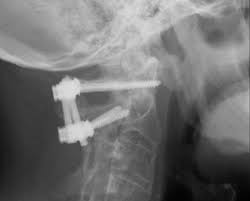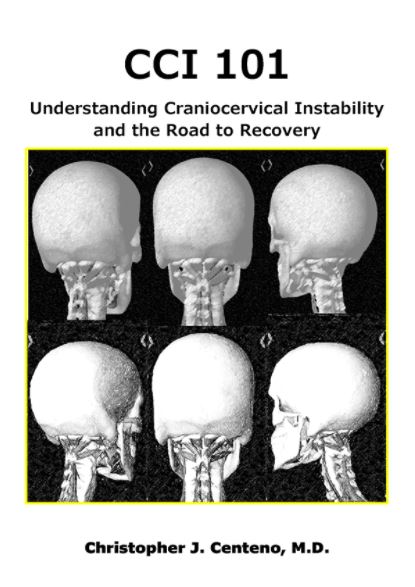Your neck pain is getting worse. The upper neck muscles are like rocks. Your chiropractor thinks you are out of alignment. You can barely move your neck. What is the Atlantoaxial joint? What is a subluxation? What is Atlantoaxial subluxation? What are the symptoms of Atlantoaxial subluxation? How is Atlantoaxial subluxation diagnosed? What are the treatment options? Let’s dig in.
What Is the Atlantoaxial Joint? (Upper Neck Joint)
The neck, also known as the cervical spine is composed of 7 building blocks called vertebrae. They are numbered from C1 which is the top of the spine to the C7 which is the lowest building block in the neck. The letter C denotes the cervical spine as opposed to the low back or mid-back.
On the backside of the neck are a series of paired joints. Like the building blocks of the spine, the joints are numbered from top to bottom. The top joint is referred to as the C0/1 or OA joint because the C1 bone meets with the base of the skull bone (occiput) to form a joint. The joint immediately beneath the C0/1 joint is the C1/2 joint which is also called the AA or Atlantoaxial joint. Why all the different names? Because the upper neck bones have additional names.
C1= ATLAS
C2= AXIS
So the atlantoaxial joint is a joint in the upper neck formed by the C1 (atlas) and C2 (axis) bones.
Bottom Line: The Atlantoaxial joint and C1/2 joint are different names used for the same joint.
.
What Is Subluxation? (Misalignment)
Subluxation is a misalignment or partial dislocation of a joint (1). A joint is composed of two or more bones that are in alignment. Think of your kitchen drawers. Each drawer is perfectly flush with the drawer above and below it. All the drawers are in alignment. During subluxation one of the bones slips out of alignment. The bone can slip forward, backward, or rotate to one side. When this occurs there is a number of symptoms that occur depending upon the severity of the subluxation.
What Is Atlantoaxial Subluxation?
Atlantoaxial subluxation is when there is a misalignment of the C1/2 joint. This can involve the C1 bone, the C2 bone, or both. Injury to the upper cervical ligaments can lead to atlantoaxial subluxation. Ligaments are thick pieces of connective tissue that connect one bone to another. The AA joint is the most mobile in the body. It is stabilized primarily by ligaments (2). When ligaments are injured or loose subluxation can occur. The most common causes of it include:
- Trauma
- Connective Tissue Disorders such as Ehlers-Danlos Syndrome
- Inflammatory disorders such as Rheumatoid Arthritis and Lupus
- Infection
Symptoms
Symptoms will depend upon the severity of the subluxation. Symptoms can vary significantly from patient to patient. The most common symptoms include
- Neck pain
- Weakness (4)
- Occipital headache
- Limited rotation of the head
- Neurologic symptoms
How Is It Diagnosed? (X-ray)
Atlantoaxial subluxation is usually diagnosed with plain neck x-rays. A neutral and forwarded flexed neck x-ray is best as it can demonstrate misalignment. A special radiographic measurement is used called the ADI (5).
It stands for the atlanto-dens interval and measures the distance between the backside of the C1 bone and the boney prominence of C2. If any doubt exist MRI should be ordered.
What Are the Treatment Options for Atlantoaxial Subluxation
Treatment will depend upon the severity of the subluxation and symptoms.
Conservative Care
When appropriate conservative care should always be the first-line treatment. Treatments options include physical therapy, chiropractic care, and traction.
Surgery Treatment

Surgery is often the treatment of choice when conservative care fails or significant subluxation exists. Different approaches and techniques exist all of which involve a fusion. The fusion stabilizes the neck by placing screws and plates into the area of misalignment.
There are significant risks and complications associated with these procedures which include bleeding, infection, and failure to fuse. Arthritis above and below the level of the fusion typically occurs and oftentimes requires additional surgery and fusion. Surgery does not address or treat the ligament injury. Rather it achieves stability by placing screw and plates into the spine. Is there a better way?
Regenerative Nonsurgical Treatments
Loose or damaged ligaments cause Atalnto-axial subluxation. Treating the ligaments can restore joint alignment and reduce pain and symptoms. At the Centeno-Schultz Clinic, we are experts in the treatment of ligament injuries. We pioneered the first nonsurgical repair of torn Anterior Cruciate Ligaments utilizing the patient’s own stem cells (6).
We also pioneered the only nonsurgical treatment options for patients with damage to the upper cervical ligaments, often referred to as craniocervical instability. Both PRP and stem cells are injected under ultrasound or x-ray guidance into the damaged or loose ligaments to accelerate repair and healing. There are three distinct phases of ligament healing following a PRP or stem cell treatment. Phase one is the inflammatory phase. Phase two is proliferative whereas the third phase is remodeling. To learn more about ligament healing please click on the video below.
In Conclusion
The Atlantoaxial joint is another name for the C1/2 joint. It is a joint in the upper neck. Subluxation refers to the misalignment of the joint. This commonly occurs due to loose or damaged ligaments.
The most common causes of Atlantoaxial subluxation include trauma, connective tissue disorders, inflammatory disorders, and infection. Symptoms depend upon the severity of the subluxation and can include neck pain, headache, weakness, and restricted movement of the head and neck. The diagnosis is made by an x-ray or MRI.
Treatment options depend upon the severity of the subluxation and symptoms. When appropriate, conservative care should be the first-line treatment. Surgical options use screws and plates to stabilize the joint. Regenerative options use PRP and stem cells to promote repair and healing of the damaged or loose ligaments. This allows patients the opportunity to promote treat the loose or damaged ligaments without the risk and complications associated with spinal surgery.
If you or a loved one has ongoing neck pain or headaches due to neck misalignment please schedule a telemedicine consultation with a board-certified, fellowship-trained expert who can review your history and images and provide you with an accurate and honest diagnosis. If left untreated the symptoms and tissue injury can progress limiting future treatment options. Act now and stop the suffering.
References
1.Vernon H. Historical overview and update on subluxation theories(). J Chiropr Humanit. 2010;17(1):22-32. doi:10.1016/j.echu.2010.07.001
2.Brockmeyer DL, Brockmeyer MM, Bragg T (2011) Atlantal hemi-rings and craniocervical instability: identification, clinical characteristics, and management. J Neurosurg Pediatr 8:357–362. https://doi.org/10.3171/2011.7.Peds1138
3.Henderson, F.C., Rosenbaum, R., Narayanan, M. et al. Atlanto-axial rotary instability (Fielding type 1): characteristic clinical and radiological findings, and treatment outcomes following alignment, fusion, and stabilization. Neurosurg Rev (2020). https://doi.org/10.1007/s10143-020-01345-9
4.Passias PG, Wang S, Kozanek M, Wang S, Wang C. Relationship between the alignment of the occipitoaxial and subaxial cervical spine in patients with congenital atlantoxial dislocations. J Spinal Disord Tech. 2013 Feb;26(1):15-21. doi: 10.1097/BSD.0b013e31823097f9. PMID: 21959834.
5.Passias PG, Wang S, Kozanek M, Wang S, Wang C. Relationship between the alignment of the occipitoaxial and subaxial cervical spine in patients with congenital atlantoxial dislocations. J Spinal Disord Tech. 2013 Feb;26(1):15-21. doi: 10.1097/BSD.0b013e31823097f9. PMID: 21959834.
6.Centeno CJ, Pitts J, Al-Sayegh H, Freeman MD. Anterior cruciate ligament tears treated with percutaneous injection of autologous bone marrow nucleated cells: a case series. J Pain Res. 2015;8:437-447. Published 2015 Jul 31. doi:10.2147/JPR.S86244





